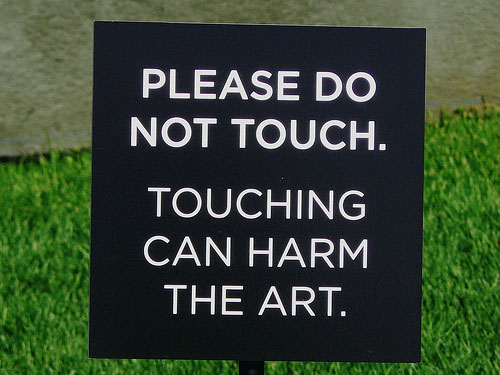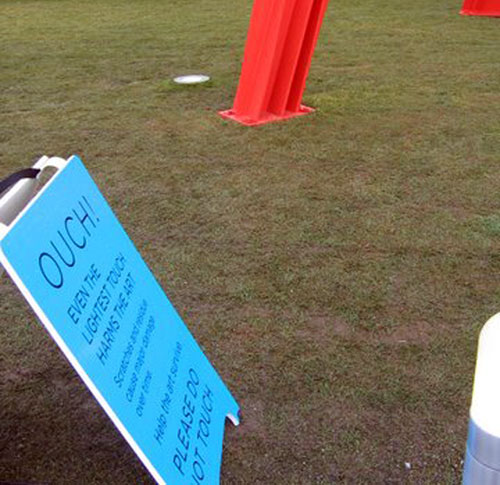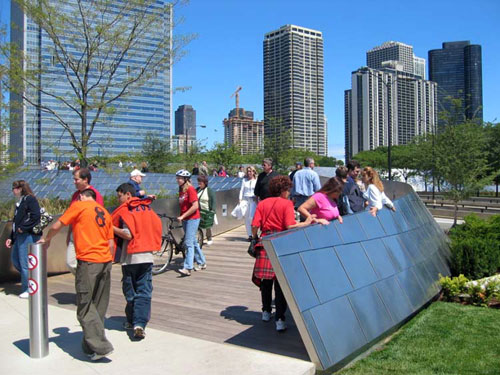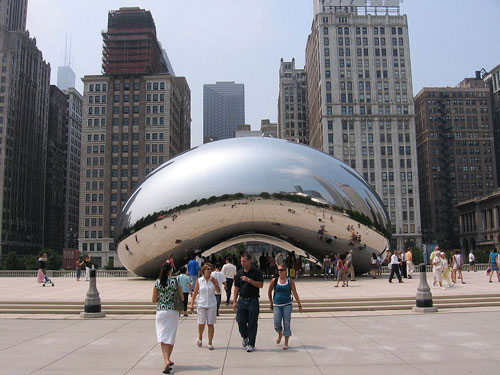Last week I was in Seattle for a couple days. A friend suggested I check out the new Olympic Sculpture Park. It was near my hotel so I walked over there to see what was up.
Seattle
Nice landscaping, nice setting, nice sculpture, but the lasting impression wasn’t made by the art, it was made by a sign (actually, about 10 signs):

They even had an extra specific warning in one spot that “Even the lightest touch harms the art… Help the art survive… PLEASE DO NOT TOUCH.”

Public art in a public outdoor space in the middle of public paths and public lawns yet you can’t touch it. The only interaction is visual. It’s standoffish. It feels like a missed opportunity.
Chicago
Contrast this with Chicago’s Millennium Park. Public art and architecture that is entirely interactive.
A fountain that spits on you:

Or a snaking bridge that you can walk or hang out on:

Or reflect in public:

Chicago understands public art in a public space. The public will only be interested if they can engage with it. Walk on it, play it in, look into it, touch it, brush up against it. If you go to Millennium Park you’ll actually see and hear kids playing over the place. I don’t think you’d see a single kid at the Seattle Olympic Sculpture Park having a good time. I didn’t see any adults who were particularly interested either.

Bjorn
on 23 Jun 08Nice post. In my home town in Iceland a sculptor’s work was featured quite prominently around the local parks. The sculptor always made sure that apart from being pleasing to the eye, they should be safe – and fun – for kids to climb on. That was the work I grew up with and subconsciously I think that kind of interaction is still what I look for in public art.
Benjy
on 23 Jun 08I’ve made a similar comment about Millennium Park during my numerous visits—that it’s wonderful and alive because people from all walks of life interact with both the art and each other. I was happily surprised when, after people began playing in Crown Fountain in ways that were maybe not expected or intended, that they didn’t put up signs warning of the dangers of playing in it and the city’s lack of liability in case of injury.
And the Bean is one of the most amazing works of public art anyplace— it demands constant interaction because every step turns it into a new work. At the same time, by reflecting the skyline it became part of city instantly. The specialness of the sculpture and how we’ve enjoyed it is the reason that I proposed to my fiancee beside it…
ceejayoz
on 23 Jun 08Well, if you don’t count the bit where they tried to enforce a no-photos-of-the-bean rule...
Christopher J
on 23 Jun 08Not to mention the Picasson statue you can literally climb on top of…
http://www.worldofstock.com/slides/ASC1358.jpg
Christopher J
on 23 Jun 08Picasso statue, even.
http://www.worldofstock.com/slides/ASC1358.jpg
John
on 23 Jun 08I know an artist who created a sculpture for a zoo. She didn’t anticipate that children would climb on her sculpture and so it wasn’t designed to withstand the wear and tear. But instead of putting an ugly sign in front of the art, she goes out periodically to repair and reinforce it. I wonder how often these signs go up supposedly to protect the interests of the artist when the artist would rather the public enjoy their work and do a little patching now and then.
Nate
on 23 Jun 08Good observation. Very true. To be a little fair though, I think Millennium Park might get a share of it’s Do Not Touch stuff. Like those ice paintings this winter? If I remember right, there were some Do Not Touch signs around those?
But just as you observed, I’m not quite sure many people enjoyed those ice paintings. For various reasons. Maybe a little for their standoffishness. Mostly though because they sucked :)
velding
on 23 Jun 08I live in Queens, New York where there is a sculpture park right on the river and it is astounding to me that not only are half of the sculptures not to be touched, some of them are actually dangerous for kids. One of the pieces has nails sticking out all over it, and it is kind of a funhouse looking, warped perspective thing that draws kids to it like a magnet. It’s just a wasted opportunity and a sad misuse of public space. Thanks for bringing this up. I’ve been wanting to vent about this for a while.
GeeIWonder
on 23 Jun 08Wow. How fitting you should choose to highlight Chicago’s Millennium Park, well-known for its draconian policies towards public art photography. BTW, I take it you’ve gotten permission from the photographers and the park to use those pictures above?
SH
on 23 Jun 08GeeIWonder, do you live in Chicago, or do you merely presume that a three year-old blog post from a non-official is correct information?
The Cloud Gate is a work of art, and like most works of art on display in museums, parks and galleries, professional photography of that work can be limited by the space owner or artist themselves. Tourists are allowed to snap away in certain parts of the Art Institute of Chicago, while professional photography is limited. In this case, the artist and space does not allow professional – meaning for profit – photographs to be taken of the work because it is impossible to enforce attribution and payment to the correct persons. If a person creates a work of art and leases or sells that work to a space, it’s at their discretion to accept or enforce payment of the work. It’s not fair to think artist shouldn’t get paid for their work.
Amateur, tourist, candid, and not-for-profit photography is allowed in Millennium Park and people not appearing to be professional photographers setting up a shot for their next calendar or postcard aren’t prevented from taking pictures.
If you live in Chicago, you are surely aware at this reasoning, as well as the city’s methods not to profit solely on these works but to accurately accommodate the artists for their work. If you don’t live in Chicago, it would be best to read up a little more about this from both sides, and use some updated information in your defense.
Martin
on 23 Jun 08Have a look at these as well, La Defense nr. Paris in France is a unique Business area with many HUGE sculptures
http://flickr.com/search/?q=la+defense&z=t&ss=2
GeeIWonder
on 23 Jun 08Maybe Chicago has just learned that prohibition doesn’t work!
Seriously though, do you think maybe there’s a little cherry picking in this sample set? What about the eye benches or any of Roy McMakin’s stuff (in that park)? Are they no touch too?!
What about this stuff?
Some art integrates people (the Bean is literally a shining example) into the art itself. But not all does, or should.
I wonder what it says about us as a culture as more and more of our art are literal mirrors of ourselves.
GeeIWonder
on 23 Jun 08That first one wasn’t me. An IP check’ll show that.
Benjy
on 23 Jun 08There was some initial misinformation and heavy-handedness by security in terms of photography at Cloud Gate. When the blogosphere erupted at the initial rules and enforcement, the city clarified the rules pretty quickly to better define what was and wasn’t allowed. So those posts linked to are out of date.
Part of the initial confusion concerned permits, etc. for professional photography and security enforcing those rules on wedding parties trying to take pics at the Bean or simply amateurs with SLRs and/or tripods. Those are allowed without a permit. If one wants to photograph it for a coffee table book or postcard, a permit is needed as well as a copyright release from the artist.
pylorns
on 23 Jun 08Yeah that is a bit strange. I especially dislike it when you go somewhere and it is public art “supposedly” but they don’t want any photographs.
huh
on 23 Jun 08Quote: “The public will only be interested [in art] if they can engage with it.”
So this rules out The Statue of David, Venus de Milo, Mona Lisa, and Campbell’s Soup I as art? Good to know!
Kjell
on 23 Jun 08If you’re ever in minneapolis, be sure to check out the Minneapolis Sculpture Garden.
Rick
on 23 Jun 08It’s funny how all the sculpture is in the loop, or just around the loop – the center of corporate Chicago.
That Picasso and that huge Calder are particularly amazing.
Evan
on 23 Jun 08If you’re ever in Chicago make sure to walk under the Bean and look up. Whoa.
Anonymous Coward
on 23 Jun 08So this rules out The Statue of David, Venus de Milo, Mona Lisa, and Campbell’s Soup I as art?
Dude, those aren’t outdoors in a public outdoor space. Gotchya doesn’t work here. If a sculpture is in a public space at “touch level” it’s going to be touched.
D
on 23 Jun 08There’s only one Chi Town – “MY KINDA O’ TOWN…”
GeeIWonder
on 23 Jun 08Dude, those aren’t outdoors in a public outdoor space. Gotchya doesn’t work here.
Donatello’s David was. So was Michelangelo’s, for almost 400 years.
If a sculpture is in a public space at “touch level” it’s going to be touched.
I abhor this attitude. We’re not a civilization of monkeys. At least, we weren’t always.
Dude.
Anonymous Coward
on 23 Jun 08I abhor this attitude. We’re not a civilization of monkeys. At least, we weren’t always.
People are monkeys because they want to touch something? that’s within reach? That’s called curiosity and it’s about as wonderful a thing as human’s possess.
Anonymous Coward
on 23 Jun 08Lots of artists love when their sculptures are touched. An example that comes to my mind is Valdès. His “Ménines” sculptures have been displayed in my city a year or two ago, in a public (and crowded) area. Children hugged them and climbed on the smaller ones. You can see pictures of some of these sculptures here: http://www.maitrepo.com/article-4509235.html
john
on 23 Jun 08you remembered the signs because you’re a designer.
nobody else remembers the signs.
Drew
on 23 Jun 08I want a t-shirt with “Please do not touch. Touching can harm the art.” printed on the front.
Grobitz McLeod
on 23 Jun 08Next time in Wash., DC check out all the outdoor art around the mall (a couple sculpture gardens + some random stuff) then complain about not being able to interact with all of it to your heart’s content.
“What? I can’t climb on this Rodin?!? THEY DON’T GET IT!”
Sam Hill
on 23 Jun 08@GeeIWonder
The post specifically talks about the Olympic Sculpture Park so the link to the troll doesn’t count.
I am not sure if you are ‘supposed to’ touch any of the art in OSP, but there are surely no signs in the park that state, “Touch the art. Touching does not harm the art. Have fun.”
@All
I find those signs ridiculous, obnoxious, distracting and not at all surprising for Seattle. The poster also doesn’t mention all of the signs that say “Don’t step on the grass” or “Stay out of this area because plants are growing”, etc. And then there’s all of the security guards who walk around and tell you not to skateboard or ride your bike.
Even more while the park is nicely placed next to Puget Sound you have to walk up to the park as it’s elevated above the main pathway along the water, hence it’s mostly out of the way and above you.
Ben
on 23 Jun 08Ha, I ride my bike by there every day. I was told off for sitting on a work of art shaped suspiciously like a “bench.” The signs are indeed ridiculous. Art should be touched, dammit! Shit, I wanted to climb inside a Gerhard Richter the first time I saw one up close.
Jed
on 23 Jun 08Thanks for this. Crown Fountain is definitely a pevz.
CJ Curtis
on 23 Jun 08If you want official “defense” of art, go to DC. I was there a couple years ago and visited one of the art galleries. There was one particular painting there that was very small but very nice, so I carefully (with hands behind my back) looked very closely at it. One of the security guards went ape shit. I guess I was breathing on it or something.
As far as the sculpture you’re referring to, the only piece that’s visible is made from what looks like solid steel I-Beam. How on Earth could you hurt that by touching it? I’m assuming there are more delicate pieces there? Stone maybe?
Shane
on 23 Jun 08Ah well, at least they used a visually-pleasing typeface for the signs.
Although what used to be a gem will soon border on being played-out: The Obama campaign (god bless’m) uses it for EVERYTHING.
GeeIWonder
on 23 Jun 08In an ideal world, the signs wouldn’t be there, and the plaques would all have consistent signing indicate whether the art is to be enjoyed on a tactile level or not. And people would read the signs before groping, out of respect for their peers, the artist and the art.
GeeIWonder
on 23 Jun 08[...]
But in a society where a prevalent notion is ‘if I can reach it’, you’re somehow entitled to ‘touch it’, signs are probably called for. Maybe the next generation or the one after that will get it.
David O.
on 24 Jun 08Without reading the blog post, I thought the signs were a joke. “touching can harm the art” ....”even the slightest touch can harm the art” So what are they going to do when a bird lands one of those delicate pieces of public art ? Hilarious.
Justin Bell
on 24 Jun 08SH: If they want to stop people making derivative works of it, then perhaps they shouldn’t have put it in such a public place. I’m all for artists getting paid and retaining copyrights, but when you have a huge sculpture that is essentially part of the city, I think it’s in bad taste to put restrictions on it. Pretty soon you won’t be able to take cityscapes without getting the consent of every architect on the horizon.
As for touching art. If it’s in an outdoor, public place and you don’t want people to touch it, then you need to design it so that it can’t be touched. Integration with the environment and its people is an important part of architecture—anything that big should obviously be designed with architectural principles in mind, otherwise it should be shrunk down and put in a display case inside an art gallery.
David Conrad
on 24 Jun 08I’m putting on my flame-retardant suit here and will chime in defense of Seattle. As a local, my views are as biased as Jason’s are of Chicago so take it with a grain of salt.
That said, Jason, your comments seem to be a little harsh in light of a key missing point – context: your argument pits work that has be design to be viewed in a gallery context (OSP) with that of sculptural work done do co-exist with people who aren’t in the space to view the art. This affords the artists in Chicago the knowledge that their materials must be selected accordingly. Going through the OSP you’ll notice places (particularly on Richard Serra’s piece) where people have not taken care to respect the work and have damaged it (knowingly or not).
Additionally, you’re comments were a bit selective in that there are, in fact, many pieces of art at OSP that DO encourage visitors to interact with them and yet you weren’t compelled to talk about them at all. Was there a reason for that?
I’m not sure what the comment about “not having fun” was really all about… Sounds like maybe you were having a bad day or something, but I can say that I’ve frequently had fun there and find that most people I encounter are having a good time.
In any case, it seems to be that your post was fairly off-base and a little obnoxious.
JF
on 24 Jun 08Additionally, you’re comments were a bit selective in that there are, in fact, many pieces of art at OSP that DO encourage visitors to interact with them and yet you weren’t compelled to talk about them at all. Was there a reason for that?
Honestly, I didn’t know that. After seeing about 10 “DO NOT TOUCH” signs I figured I couldn’t touch anything.
The post was just about my impression of the place. The entire experience felt a bit condescending—like the curators were screaming at the public over and over NOT TO TOUCH this and NOT TO TOUCH that. I wasn’t having a bad day, I was just really surprised at the number of signs constantly telling me what NOT to do.
Kevin
on 24 Jun 08I think your impression of the sculpture park in Seattle is dead on accurate. I have visited Chicago and for a huge city I found it quite friendly and accessible, much like their public art.
Seattle is a very beautiful city. The people of Seattleare very proud of their town and do everything they can to make sure that it’s a nice place to visit but in their hearts, they don’t want you to fall in love with their city, because they don’t want you to move there. Thus the impression that Seattle gets 380 days of rain a year. The secret is, from June to September the weather is postcard perfect, and when Mt. Rainier is out, there isn’t a more beautiful place in the world.
Your impressions of Seattle are correct, and the people have you just where they want you…still in Chicago.
David Conrad
on 24 Jun 08@Kevin—Sssshhhhh….
@JF – so was your concern an issue of information design/experience design or rather of the philosophy of the park?
Stefan
on 25 Jun 08I really like Peter Eisenman´s concept of the Holocaust Memorial in Berlin. You can get an concrete impression of beeing left alone just by walking through a labyrinth of differently high pillars.
You feel kind of lost although the memorial is always crowded. Kids are playing in it, people sit on the pillars. But everybody seems to get the point somehow.
http://flickr.com/photos/7205019@N04/2479184908/ http://flickr.com/photos/thomack/364738601/
Michael Max
on 25 Jun 08I live in Seattle. I’ve been the sculpture park, and find the “don’t touch the art” signs to be pathetic and annoying. Please, they are made of steel and concrete and such. If they can not take a little touch and connection then what is the point. It just perpetuates that idea that ART is inaccessible. There is no real beauty, or life for that matter in the sculpture park. Art should inspire and engage. The sculpture park fails in these way.
joe
on 25 Jun 08As a previous poster mentioned, one of the largest signs is near the Richard Serra piece that looks like large vertical waves, fabricated from untreated metal. Without any protection on the metal, the effects of nature are ultimately part of the piece, which corrodes and discolors according to the patterns of wind and rain. It’s unfortunate that Mr Serra doesn’t also see people as part of the natural environment in which his pieces exist; why should rain be privileged over handprints?
Years ago, one of his works was installed in a public place in paris; after he discovered footprints on it, it was ultimately disassembled and put in storage. The line between public participation and vandalism is sometimes finer than it might seem…
http://www.nytimes.com/2008/05/07/arts/design/07serr.html?ref=arts
dave
on 25 Jun 08I posted the above comment, which was auto-deleted without warning several times for some reason. Trying to understand why…
JF
on 26 Jun 08I posted the above comment, which was auto-deleted without warning several times for some reason. Trying to understand why
Oops, sorry about that. We use akismet to filter spam in the comments. Unfortunately sometimes good comments are filtered out by accident (we can’t really control what it filters). You may want to get in touch with the Akismet folks to find out why your email address or URL may have triggered the filtering.
Justin Bell
on 26 Jun 08Don’t bother contacting Akismet. In my experience, they do absolutely nothing, and that is obvious when you go to their site to try and get yourself unblacklisted. They don’t care.
Gerlando
on 30 Jun 08Kevin, That’s a really insightful post there. I’m a relatively recent transplant & I find your comments dead on.
I haven’t been to the Sculpture park yet, but there IS accessable art around the city, like the fountain & red tube sculpture at the Seattle Center and the Fremont Troll. I think the Space Needle itself counts as well since it’s a stunning piece of architecture that you can walk through.
Håkan Bruce
on 30 Jun 08This got me thinking of a sign I saw in Sydney a while back. Not my photo but the sign is the same: http://lh3.ggpht.com/_jyAB0bJZRV0/Rup3RmIiYmI/AAAAAAAAAHk/DvATjUR4lF8/CIMG0179.JPG
This discussion is closed.